This is the kind of newsletter you write when you are sick but also looking after two other people who believe themselves to be much sicker, and a dog who is full of the joys of spring in every way.
I have hardly had a moment to write, though I got the date list done on Sunday, thinking how well I was doing, and then have not done anything until this morning....
But I will try to finish over the weekend if I do not finish by tonight, for maybe the writing gods will bless me with both speed and accuracy, as well as a sleeping dog!
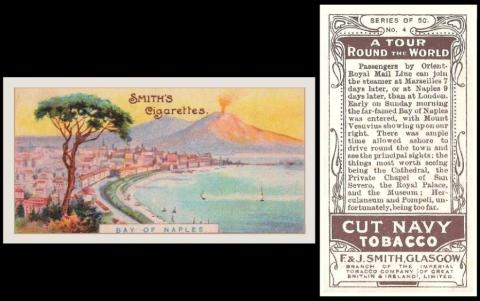
F. & J. SMITH [tobacco : UK] "A Tour Round The World" descriptive - "Cut Navy Tobacco" brand (1906) 42/50 - S548-440 : S84-16.2
So the first words I wrote down were "1st underground subway in Italy - Passante Ferroviana di Napoli". And even better, it opened today, in 1925, making it a centenary card.
Now in 1925 tourism was booming, there were lots of young people who wanted to change their lives and rebelled against the drudgery of the past. They had money, and no jobs, and no worries, and they travelled about exploring the continent like an army of glittering wasps. Of course there were lots of young people who had none of this, who had no jobs and lots of worries, small mouths to feed, a husband who never came back from the war, or who did, but was so injured that they needed constant care and attention, and sometimes that was worse than them not coming back at all.
One of the new trains was a direct line from Rome to Naples, and it was planned so that the time consuming reversing of the trains in and out of Naples Central Station was bypassed, making travel even quicker. Also included in the plans was an underground railway, which would bypass the overground completely, and that was our train.
Works on this began in 1906, but the tunnelling was harder than they imagined, and then the First World War came along. This had many effects, the lack of man power, and the damage to the buildings above the ground, and also the damage to the earth and the infrastructure. Naples was also bombed, in March 1918, by a German airship based in Bulgaria, the L.59, which caused widespread panic and about fifty casualties.
So it was not until the 20th of September, 1925, that you could at last travel, underground, from Naples Central Station (now Naples Piazza Garibald) and out west towards Pozzuoli.
And, despite changes, and updatings, you can still use the same line, between Barra and San Giovanni.
Now in our World Tobacco Issues Indexes you will have to hunt for these a bit, because they are listed after "Shadowgraphs", taking the T of Tour as the first letter and ignoring the A in front.
In both our original World Tobacco Issues Index. RB.23, first published in 1956, and our updated version, RB.124, published in the year 2000, you will find a very lengthy description which also includes the postcard backed and the handwritten advert versions above ours, but our part reads :
- A TOUR ROUND THE WORLD. Sm. Nd. ... S84-16
2. With series title (50). See H.75 and Ha.76. Multi-backed in brown, 10 wordings.
And the same is reprinted in the updated version, just with a new card code of S548-440.
We also know that on the packaging, as well as on a little advertising card also issued the factory, the correct title is shown as "Bright Cut Navy", not just Cut Navy. Yet the short form wording, of just "Cut Navy", seems to be universally used on the reverse of Smith`s cards.
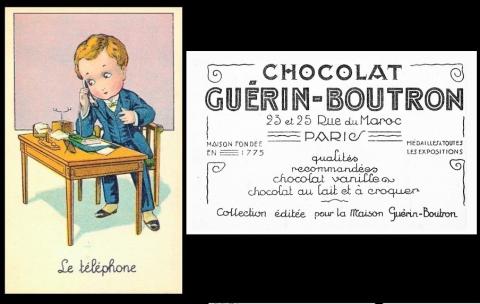
Guerin Boutron [trade : chocolate : O/S - Paris, France] "Occupations"? - Un/??
We have had this set before, but only as a representation for breakfast, so it will be easy enough to swap the other.
I like this very much, and it seems a totally true representation of the events of today`s, second, centenary, which recalls a downing of all tools and outing of all telephone and telegraph workers in Paris, today, in 1925.
For I imagine that there was many a businessman who said, oh never mind, I will just man the phones myself, how hard can it be? Then found out the hard way, over the two hours that the strike continued. It was probably the hardest two hours in his life, and I can also guarantee that no friendly word of thanks to his workers for returning ever crossed his lips at the end of it.
The strike was, as is often the case, a protest against was was considered low pay. In addition, most, if not all of the strikers were women - for it was, for the most part, their nimble fingers who operated the telephones and telegraphs, transcribing the messages with neither fault nor delay.
This is a much different style to the early Guerin Boutron cards, and I do not know how many there were of them. They also seem to have toned to a kind of pinky brown, which is a good way to spot them.
It is unlikely that she is eating Weet-Bix, but you can tell she has milk, because she has a feline friend waiting anxiously for any spillages - or more likely trying to make her feel guilty so she shares!
This is a much later card than the ones we have shown from this maker before, and it is very Art Deco in its design, especially the text on the reverse. There something else from which we can instantly know this date though, that being the the child`s eyes, which are bigger than you would expect. This is a nod to the beginnings of what we know as "googly eyes" - and they were first seen in a comic strip by Billy deBeck, which began in 1919, and was called "Barney Google and Snuffy Smith". Mr. Google had very large expressive eyes and pretty soon everyone was calling them "googly eyes", encouraged all the more so, slightly later, by a hit song called "Barney Google with the Goo-Goo-Googly Eyes", which was sung by Eddie Cantor, amongst other people.
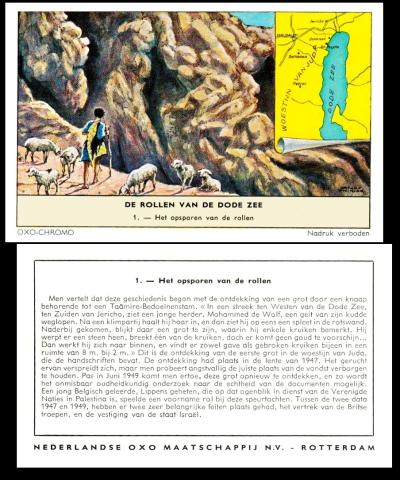
LIEBIG [trade : meat extract : O/S - South America] "De Rollen van der Dode Zee" (1962) 1/6 - F.1777 : S.1779
Away from the centenaries now, and on to the staggering fact that although the Dead Sea Scrolls were uncovered in 1947, they were not made available to the general public until today in 1991, when they were at last digitised by the Huntington Library.
The scrolls were discovered, quite by accident, at the Qumran caves, near Ein Feshka, on the northern shores of the Dead Sea. Over ten years, between 1946 and 1956, they were slowly retrieved from their hiding places. They were dated from the third to the first century B.C. and they are written in a variety of tongues from within the Jewish faith. Some are just fragments of a story which will never be revealed, and others are transcripts (or maybe even the originals) of lengthy passages and sections from almost every book in the Hebrew Bible, except the book of Esther. They foretell the development of Christianity and of Judaism.
And there are some fifteen thousand scrolls in all, which is thought to be but a portion of what was originally buried there, for safe keeping, by someone who we know not at all.
They were first found by a Bedouin shepherd, his cousin, and his friend. At that time there were only seven scrolls, which were found pushed into jars in a cave. These were extracted by the Bedouin very slowly, and carefully, between November 1946 and February 1947, and taken to their homes. They hung them up and showed them to selected people and friends, but then they took them into town and showed them to a dealer in Bethlehem. He had no interest in them at all, and said they were worthless scraps of paper.
They were not deterred by this and eventually did sell a few of the scrolls to a part-time antiques dealer for about thirty dollars. Then someone from the American School of Oriental Research got involved, believing them to be Chinese. In 1948, he had four scrolls installed at St. Marks Monastery to be photographed and worked on. However the political climate led the Archbishop to believe that they were not safe there and the scrolls were removed, to a Church in New Jersey, USA.
The Archbishop then, in 1954, places an advertisement in the Wall Street Journal offering the scrolls for sale on the open market. An American buys them, but is later discovered to be working for the State of Israel, who already have three of the scrolls in the Hebrew University. The seven scrolls are then given a purpose built home there.
Today they are housed in the Israel Museum, in Jerusalem, and face an uncertain future. And they are at great risk of becoming a casualty of war, bombed, or burned, to nothing.
There are also rows about who actually owns them - The Israeli government may hold them, but they were found by the Jordanians, and only acquired by the Israelis when Jordan was deemed the loser in the 1967 Arab-Israeli War; and Jordan disputes their current ownership immensely. Then, in 1948, during another conflict, they were moved to Beirut, in Lebanon, who maintains that this was a gift and that they now own the scrolls, their removal being illegal.
This is the Dutch version of this set, and the cards are :
- Het opsporen van de rollen (discovering the rolls)
- Binnenzicht van een der grotten (interior view of one of the caves)
- Oudheidkundige vondsten in de grotten (archaeological finds in the caves)
- Het Scriptorium van Qoemraan (The Scriptorium of Qumran)
- De Essenen en Qoemraan (The Essenes and Qumran)
- Werkzaal in het Modern Museum te Jeruzalem (Workroom at the Modern Museum at Jerusalem)
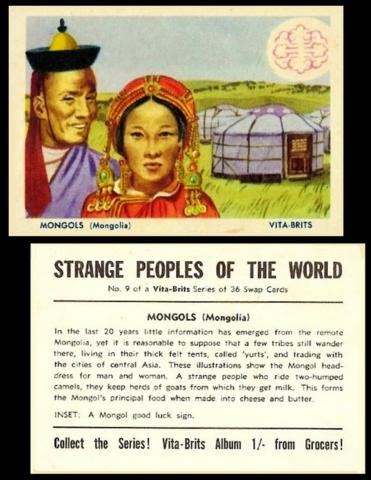
CEREAL Foods [trade : breakfast cereal : O/S : Australia] "Strange Peoples of the World" (1958) 9/36
Today, though it seems unlikely that such a thing was truly recorded, saw the birthday of Kublai Khan. Now he is not very visible on cards, even if I had a whole week to hunt, but I did find this, which will suffice. After all, Kublai Khan was Mongolian - a General and a statesman, and yes, he was also related to Genghis Khan, being his grandson, and by far his most natural successor.
He also did what grandpa Genghis could not, and completed the conquest of all China, becoming the first man to rule over a more or less unified country.
Sad then, that we mainly know him from someone else, the poet Samuel Taylor Coleridge, whose "Kubla Khan : or a Vision in a Dream", was written in 1797 and then only published, at the insistence of Lord Byron, in 1816. The poem was reputedly composed after an opium dream, which brought in material from the book he was currently reading, about Xanadu, the summer capital founded by none other than Khublai Khan. It starts, rather evocatively, with the following lines : "In Xanadu did Kubla Khan / A stately pleasure-dome decree"
Though Kublai, and Genghis, had many wives, and concubines, I still fail to see them as pleasure-oriented. Though they look fleshly enough to have gained pleasure from eating, maybe they had other indulgences too.
Kublai was actually the fourth son of Genghis Khan`s first born, Tolui, but he was also the second from who we know as his second wife, (though his first wife was very much alive). She was a very powerful and adept leader called Sorghatani Beki, or Queen Sorghagtani. She steered Kublai, more than the other children, into following in grandfather`s footsteps - and it seems likely that she also engineered a meeting between the young Kublai and his grandfather, during a hunting expedition, just three years before Genghis died, during which it appears the two were very impressed with each other, though young Kublai was only nine years old.
After the death of Genghis Khan, there was trouble and unrest, which continued long enough for his to have to fight his brothers Mongke in 1260, taking his title of The Great Khan, and Arig in 1264.
These two acts could have eternally divided the country, were it not for the fact that in 1271 he started an entirely new dynasty, in which, he claimed, he had been chosen, from above, and was of direct lineage to the first Chinese ruler of all. He even gave himself a title, The Great Emperor Shizu of Yuan.
These were all pretty impressive statements, and his Great Yuan Dynasty did indeed come to rule over most of the land we now know as China, as far as Siberia and Korea. He would also come to rule parts of what we now call Vietnam, and Burma, as well as several of the island nations.
And it only ended with his death in 1294.
For such a character, it seems odd that I could not find a card of him more readily. We know he appears on two other cereal sets, both issued in Canada, the 1964 set by Nabisco, "World Conquerors" (as card 18 - with Genghis Khan preceding him as card 17) and the 1966 Post Cereal "History and Explorers" (as card 2).
However, if you look closely he does appear in the 1996 set of Doctor Who CCG, published by MMG Ltd. This relates to an episode right back in the first ever series, when the Doctor was played by William Hartnell (who also appears in this card). Though the episode was called after, and mostly dealt with, Marco Polo, towards the end of the episodes the Doctor attempts to retrieve the TARDIS, stolen and imprisoned by Marco Polo, by playing Kublai Khan at a game of backgammon. Strangely, as it is the most lavish of every episode in the early years, it no longer exists, only as a melange of stills that tell the story without movement, whilst the soundtrack is played along.
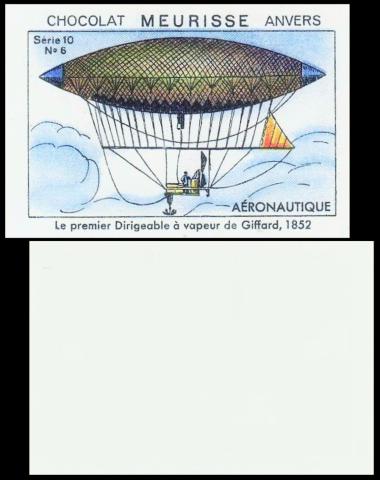
Chocolat MEURISSE [trade : chocolate : O/S - Belgium] "Aeronautique" - S.10 (1930)
In a change to what I wrote down (which was the 1568 Battle of San Juan de Ulua, where the Spanish Navy actually trounced the British one) we have an airship.
This is the Giffard dirigible, which, today in 1852, travelled some seventeen miles from Paris to Trappes and became the first powered, and steerable, airship to carry passengers.
It was actually built in France, by Baptiste Jules Henri Jacques Giffard, who was born on the 8th of February, 1825. In the same year, he had invented the steam injector, and this was pretty much the secret behind the airship, which was powered with a steam engine using the same method. Part of the secret of its great manouevrability was that each end was not rounded and floppy, it had a decided point, with a proper rudder at the rear end.
And so it was that today, the 24 September 1852, Giffard flew the airship on a grand journey that took him three hours, at a speed of just over five knots, and included a few aeronautical feats, turns and circles, just to amuse his passengers. Unfortunately, when he turned for home, with the intention of making a return journey the same day, he discovered that the wind had picked up and his engine was not sufficiently powerful to do that. With hindsight, always an amazing thing, perhaps the stunting had wasted too much time - though there is also the thought that if the wind had picked up mid flight it could well have ended in disaster.
He was the hero of France, and even became a Chevalier of the Legion d`Honneur, but it ended in tragedy, when he started to lose his sight, and believed he would be useless. And so he killed himself, in 1882, leaving his estate and ideas to the nation.
This set is relatively easy to acquire, and it often turns up as complete sets, though that tends to spoil the fun of the hunt a bit.
The cards are :
- Les freres Montgolfier et la premier experience de 1783
- L`ascension de la Montgolfiere en 1783 (21 novembre)
- Le plus grand spherique (Ballon captif Exposition 1878 Paris)
- La 1re descente en parachute par Garnier, 22 octobre 1799
- Un depart de la Coupe Gordon Bennet
- Le premier Dirigeable a vapeur de Giffard, 1852
- Le premier Dirigeable par force musculaire (Dupuy) de 1872
- Le Dirigeable electrique des freres Lunandier (1883)
- Le 1er Dirigeable de Santos-Dumont a moteur a explosion
- Mat d`amarrage ... Le Los Angeles
- Le Ville de Bruxelles
- Navire aerien, 60,000 metres cubes
And I will translate them when I have the time, which I do not now.
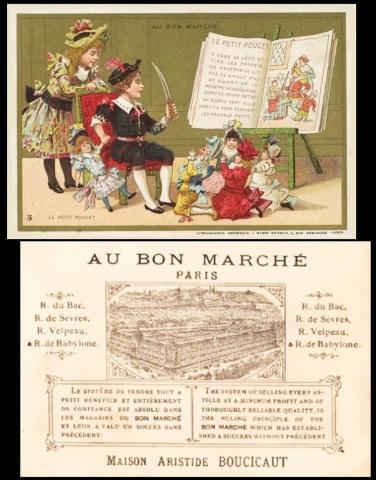
Au BON Marche [trade : department store : O/S - Paris, France] "La tales de Charles Perrault"(1900?) Un/??
Today, and oh how we need it, brings a little magic -for it is National Open the Magic Day.
It happens every year, on the same date, and yet few seem even to have heard of it. It is also very simple to do, it just asks you to sit down and read a picture book to a child of your own or one you wish to inspire. The idea is to read the words and point to the object, and hopefully, if you are inspiring enough, that child will become a reader all on them own. If you don`t have a child, why not volunteer at a library, or somewhere else near you which is almost certainly crying out for people to come along and spend even ten minutes reading to a child.
But wait. For it is not just children who need to learn to read. Many adults never got that chance either. Just imagine, for a moment, how being unable to read can impact someone`s life, just simple things, like shopping, cooking, filling in forms, and handling bills and banking. And you will realise that adult education centres are equally in need of help.
This card says, in small letters "Le Petit Poucet", which is the French version of the character Hop o`My Thumb. This is a fairy tale collected by Charles Perrault and first published in 1697. It tells the tale of seven brothers, abandoned in the woods by their parents. The eponymous character is so tiny that he is the same size as a normal human thumb. And yet, somehow, with the odds so high against him, he uses guile, and learning, to defeat an ogre, and save his brothers from certain doom. More than that, he falls in love with a rich nobleman`s daughter and lived happily ever after.
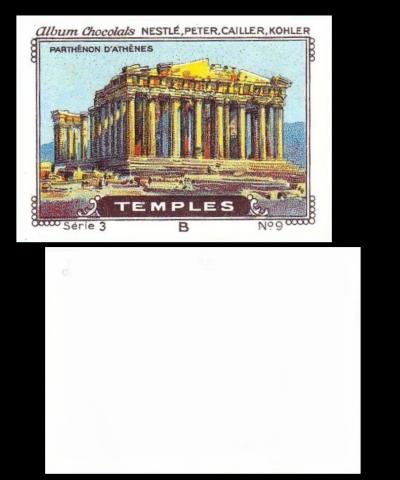
NESTLE, Peter, Cailler, Kohler [trade : chocolate : O/S - Switzerland] "Temples" - S.3.B (1930s) 9/12
And so we end, with a very sad tale indeed. For until today, in 1687, this magnificent building had survived more or less intact for its entire life. Indeed, for most of that life, it had been a great temple, to the Goddess Athene, and the building had been revered and cherished. To this day it is regarded as the most splendid of all the Greek temples in the Doric architectural style.
Wills` "Wonders of the Past", card 38, shows it as it would have been, and tells us that "The great temple to Athene Parthenos on the Acropolis at Athens, known as the Parthenon, is universally conceded to be the finest masterpiece of Greek architecture and sculpture. It was begun in 447 B.C. after the defeat of the Persians at Marathon, by the architects Ictinus and Callicrates at the command of Pericles, and Pheidias, the supreme sculptor, was entrusted with its decoration."
However in 1687 the region had been swept into the Great Turkish War, a fifteen year series of battles and skirmishes which was basically the Ottoman Empire`s attempt to spread into Europe, and Europe`s attempt to stop them.
It was a war with many fronts, one of which revolved around the capture of Athens, and its riches. The man in charge of one of those fronts was Captain-General Francesco Morosini, and his job was to prevent Athens, and those riches, falling into Turkish hands. Unfortunately the Turks had the upper hand in more ways than one, as they were high above the city, living in and around these ancient buildings. Then Morosini had a plan, to use the Parthenon as a target and flush the inhabitants out.
What he did not know, until it was too late, was that the building was packed to the rafters with gunpowder, being stored in the relative dry, until ready for use. So when he fired his opening round, the explosion which resulted was a lot more powerful than anyone had imagined. Almost immediately, the roof collapsed, the walls were blown outwards then sicked back in, and a lot of the columns were left laying uselessly on the floor. Over three hundred men were killed and it also started a fire, which laid waste to the entire area. But it did result in the capturing of Athens, for a while, as the Turks returned less than a year later and the Venetians were forced to withdraw.
This may have been a good thing for the Parthenon, as Morosini had intended to blow it up again and pull it all down, but he just did not have the time before he was forced to retreat.
As for our set, it is a mixture of many sorts of temple. The cards in the set are :
- Temple Brahmanique d`Angkor-Vat (Siam)
- Temple Bouddhique a Ceylan
- Temple d`Isis (Egypte)
- El Castillo (Yucatan)
- Temple El Khasneh, Gorge de Petra (Syrie)
- Pagode de Wutchang (Chine)
- Mosquee d`Omar a Jerusalem
- Temple Mahometan, Agra
- Parthenon d`Athenes
- Pantheon Rome
- Saint Pierre de Rome
- St. Basile a Moscou
It is also a set of many forms, for you can find it issued by most of the makers in the group. So we have it as :
- Cailler`s - Serie XVIII - "Temples" top margin "Cailler`s Chocolate Fins" in white in the brown cartouche at bottom.
- Peter, Cailler, Kohler, Nestle - Serie 3 - "Temples" in white in the brown cartouche at bottom, below which is the letter "B", maker`s names in the top margin
- Peter, Cailler, Kohler, Nestle - Serie III - "Temples" in white in the brown cartouche at bottom, maker`s names in the top margin
This week's Cards of the Day...
actually did have a reason, though when I revealed the theme of the week I could not find my notes, and looking online produced nothing at all relating to a chocolate event for this week, let alone September. Dogged determination discovered it though - and it was National Choose Your Chocolate Day, annually on September 16.
The idea behind this is to not be restricted by place or centre, but to explore the entire world of chocolate and find a new favourite that you never tried before.
There is also a rather fun back story, as it is a relatively new day, only set up in 2020, to mark the birthday of Mary See, the founder of See`s Chocolate
So our clues were :
Saturday, 13th September 2025
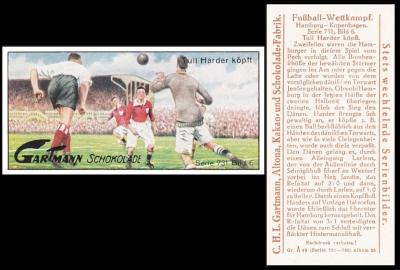
Here we have an International match, on a card issued with German chocolate.
This is rather an oddity in the chocolate world as I have not been able to turn up any other cards in this series, though there are a couple of this one on various sites. In addition, the highest numbered Gartmann set listed on the Trading Card Database is Serie 629, issued in 1927 - but ours is over a hundred sets higher, at Serie 731. Whilst the Football Cartophilic Information Exchange raises the total a bit higher, to serie 700, but still does not include ours.
The subtitle, on the reverse, may give the clue to why this set is so scarce, for it says "Hamburg-Kopenhagen / Serie 731, Bild 6 / Tull Harder kopft" - and "Tull Harder kopft" also appears in the top right hand corner on the front of the card. Now Tull Harder was the nickname of Otto Fritz Harder, and the nickname was, indeed, after the English footballer, Walter Tull, the two men`s style of play being similar. Otto Harder was a really good footballer, who ought to have been remembered for that, and not the directions in which his political beliefs led him. Maybe this is why, after that war, and those events, this set was a bit tainted, and was allowed to slide away out of sight. Indeed, even in the 1970s, when he was included in a brochure, it was called in, and he was excised from the re-issue.
The "Hamburg-Kopenhagen" seems to suggest that the series shows matches in an early incarnation of the UEFA Cup, though I was surprised to learn that event only started in 1971.
The earliest attempt to match football teams from different regions seems to have been the British Home Championships, which was held from 1883, but only for England, Ireland, Scotland, and Wales.The first European version seems to have come along in 1927. That was the Central European International Cup, but neither Hamburg nor Copenhagen took part or would have been eligible, for it was country teams, and the only entrants were Austria, Czechoslovakia, Hungary, Italy, Switzerland and Yugoslavia - none of which could even have contained players from Hamburg and Copenhagen.
But maybe out there is someone who can either tell us more about an event it could be - or supply the names of some more cards from this series....?
Sunday, 14th September 2025
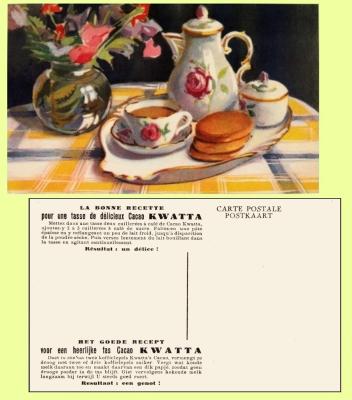
This card celebrated the fact that chocolate is both something we eat and something we drink, and, more than that, the fact that the drinking came along many centuries before the eating was ever imagined.
During the late 1940s, Kwatta gained a name for themselves with a superb selection of film star cards. However this postcard comes from an earlier time, and it is included here because chocolate, when first discovered, was not something to eat, only to drink.
That all started with the Mayans, in Mexico and Central America. Somehow they discovered that if you somehow broke down the hard shell and ground the large beans that grew all over the area, you could mix it with water and it would kind of flavour the drink. Today we would not consider it very palatable, and nor did they, so they started mixing it with chillies and other spices, which gave it a novelty value if did nothing for the taste. It then moved into Europe when the Mayans were conquered, and their wares plundered. This was when the chillies etc were removed, but on finding any form of taste lacking, sugar, or honey, was added to sweeten it.
It was not until the 1820s that chocolate was eaten and not drunk. For that we can thank a familiar name, Coenraad van Houten, from Amsterdam, who invented a machine to press the cocoa bean and separate it into two parts. the fat, which he did not want, and the powdery grain, which he did. However he did not make this into a bar of chocolate, he just made a finer, less fatty, chocolate drink. For those who needed fattening up, like invalids, it was recommended that milk be added. Which is where we get the idea of milk with hot chocolate today.
For the bar of chocolate, we have to thank someone else - and they come along tomorrow....
Monday, 15th September 2025
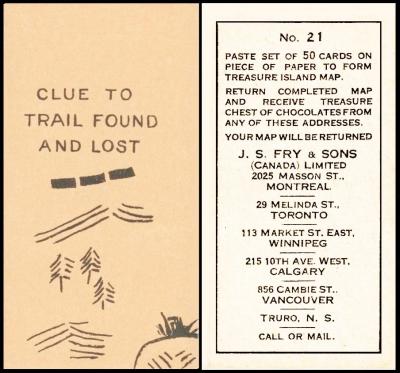
So yesterday we ended abruptly, but now we can continue, with an introduction to Joseph Storrs Fry. He was born in Bristol in 1767, and his father was a manufacturer of what may seem two very unlikely things, chocolate and soap, though he also ran a printing business. The chocolate making had led to a proper factory, and a business, called "Fry, Vaughan, and Company", but it does not seem that this side took off until Joseph took over, in 1795. Some say this was because his father had died, but it is written in such a way that suggests our man just took it over, though it seems likely his father had died because it has been renamed, in his mother`s name. However, in 1795 he would have been eighteen, newly come of age, maybe it was gently gifted to set him off in a career, or maybe he expressed an interest. We will never know that. We do know that he was keen to expand and to mechanise, and he ground his beans by steam power, using a machine he got from none other than James Watt.
His mother died not long after, in 1803, adding more weight to the demise of his father, as they were presumably of similar age. Our man then took a partner, a Doctor Hunt, and a wife, Ann Allen, with whom he would have seven children. Three of these are the sons in J. S. Fry & Sons, the name that the company took when Doctor Hunt retired in 1822, so it seems likely that the other four were daughters.
Our man died in 1835. So it was not him at all who in 1847 was looking for something novel to sell and he stumbled on the old idea of splitting off the fat from the cocoa. He went back to the cacao bean, and ground it without removing anything, then used it to form a liquid paste which he added sugar to and poured into moulds. They were pretty basic moulds, just a bar shape, but suddenly he realised he had invented a bar of chocolate.
It had its faults - for one thing, even with the sugar, it was bitter, and it was a very dark colour, hence the name, that we use to this day, of "dark" chocolate.
What we know as "milk" chocolate was something else entirely, and for that you can thank the Swiss chocolate maker called Daniel Peter.
This is a very unusual card, and made more so by the fact that you will not find it listed in our updated British Trade Index, save for the brief mention, in the heading, of "Some cards issued in Canada".
In fact, it is only in our original British Trade Index that this set, and three others, appear, described as :
5. CANADIAN ISSUES. Inscribed with Montreal address. Issued 1928-1934.
- CHILDREN`S NURSERY RHYMES (A). Sm. 66 x 36. Nd. (50) ... FRY-37
- RADIO SERIES. Sm. 65 x 35. Nd. (25). USA/V.38 ...FRY-38
- SCOUT SERIES - SECOND SERIES. Sm. 65 x 35. Nd. (50) USA/V.40 ... FRY-40
- TREASURE ISLAND MAP. Sm. 66 x 35. Nd. (50). USA/V.41 ... FRY-41
The first thing that stands out from this is the fact that there is only a second series listed for the scouts and not a first. This is made even more obvious by the numbering, which skips between 38 and 40 in both the USA catalogue and our card codes. This seems to suggest that it was believed that a first series would turn up, and could then be more easily slotted into the right place.
There is another theory, and that is that the so called first series was the British home issue, by Fry`s, just renumbered, and shipped to Canada. There are several rather unplausible reasons cited for Fry issuing their set once, and then changing the numbers and issuing it all over again, but the idea of reprinting it with those different numbers and then shipping it off to the Dominions is a much more sensible one. And it is made even easier by the fact that there was no address on the British version, only the following wording : "FRY`S / PURE COCOA / & CHOCOLATE. / 300 GRANDS PRIX, GOLD MEDALS &c / Makers to H.M. THE KING." Anyway, after that run had ended, that would have been the perfect time to introduce a brand new "Second Series", in Canada alone.
Returning to our set, there is another question, for the reverse states "PASTE SET OF 50 CARDS ON PIECE OF PAPER TO FORM TREASURE ISLAND MAP. RETURN COMPLETED MAP AND RECEIVE TREASURE CHEST OF CHOCOLATES FROM ANY OF THESE ADDRESSES. YOUR MAP WILL BE RETURNED." This makes it sound like the map you stuck down would be returned, not new cards, so that could account for the scarcity of this set today, as almost certainly the maps, once so carefully pasted, were all thrown away on their return.
As for the addresses, even more curiosity, for they prove that this set once had an amazingly large distribution area, right across :
- 2025 Masson St., Montreal
- 29 Melinda St., Toronto
- 113 Market St. East, Winnipeg
- 215 10th Ave. West, Calgary
- 856 Cambie St., Vancouver
- Truro. N. S. [Nova Scotia]
This means that there ought to be so many cards floating about that we are finding them everywhere, especially in Canada. And yet we are not.
Now since starting this i have learned that there is a page on the Hobby News Daily.com website which not only shows all the cards, but the packet from "Fry's Treasure Island Bar". In fact it was not just a map, it was a puzzle, "Find the Pirate!", and the answer to that puzzle is also shown on that site.
Tuesday, 16th September 2025
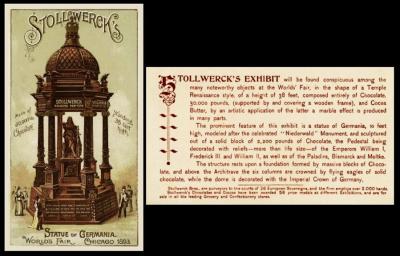
Today we are off to The World's Columbian Exposition, also known as the Chicago World's Fair, which was held from May the 1st to October the 31st, 1893.
The exhibition had many items of grandeur, but today we are going to push chocolate to its limits, with this fountain, which stood thirty-eight feet high, and was made from 30,000 lbs of chocolate. It was housed in the Agricultural Building, which alone covered nineteen acres
This postcard has a reverse that suggests it was handed out at the exhibition itself, for it goes into great detail about what to look for when looking at the statue - that the marbling of the columns is caused by applying cocoa butter, that the statue beneath the dome is modelled after the "Niederwald" Monument and sculpted out of a solid block of 2,200 pounds of chocolate, that the flying eagles atop the columns are also solid chocolate, and that the reliefs on the pedestal are more than life size and depict Emperors William I, William II, and Frederick III, plus Bismarck and Moltke. With all this weight, it is no wonder that the whole was supported by and covering a wooden frame.
Oddly, there was another Germania fountain in the same exhibition, but outdoors, north of the German building, and not made of chocolate; this figure held a lamp, which illuminated in the darkness.
Wednesday, 17th September 2025
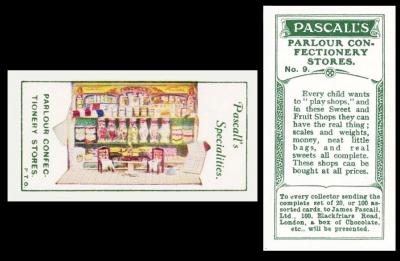
It may not be immediately apparent from this card that there is a chocolate connection at all, but the back tells us that you can exchange a complete set of twenty cards, or a hundred assorted ones, for a box of chocolates. To be honest I hoped to show the card which has three tiny chocolate figures of a soldier, a sailor, and a nurse, in cloth uniforms - but could not find anyone who had one.
Then, as usual, I set eyes on this shop and that was it. When I was young I would spend hours gazing at these little toys, with small bottles of assorted coloured "sweets", to measure, and pretend you were selling, imagining myself in control, whilst my mother said they were worthless, and wasteful, and derided my shop-owning ambitions, and usually slapped me for good measure, none of which ever worked, except to fix my heart all the harder towards the day when I would prove her wrong in all respects. And I did, eventually, do so, renting part of a shop, selling antiques and collectables, for twelve years. Furthermore, though this is, at the moment, just a memory, I can feel the force growing strong again, and I know that one day I will return to my calling, just a little further out of reach, so it cannot be spoilt.
This set is proven by its entry in our original British Trade Index to be both wonderful and complex, for that reads :
- PASCALL`S SPECIALITIES. Sm. 66 x 35. Nd. 1/20, many numbers with two or three subjects, or variations of wording on back. ... PBS-13
description - last line of text
- (a) Golden Maltex - "...ounce"
(b) Golden Maltex - "...out delay"
- (a) Barley Sugar - "...children"
- (a) Queen Mary Chocolates - "...Boxes, 1/2-lb., 1-lb. & 2-lb."
(b) Queen Mary Chocolates - "...to that of the Chocolates"
- (a) Creme de Menthe - "...crystallized"
(b) Creme de Menthe - "...crystallized form"
(c) Creme de Menthe - "...tins, 2 sizes"
- (a) Pine Lozenge - ...is also very comforting"
- (a) Fruit Bon-Bons - "...and by weight"
- (a) Butter Almonds and Walnuts - "...Factory"
(b) Butter Almonds and Walnuts - "...full working day"
- (a) Domino Chocolate - "...1/2-lb. and 1-lb. boxes"
(b) 6d. Court Chocolate Neopolitan - "...passed"
(c) White Heather Chocolate" - "...boxes"
- (a) Parlour Confectionery Stores - "...bought at all prices"
- (a) Smoker`s Companion - "...signs. Two sizes."
(b) Smoker`s Companion - "...the youngsters"
(c) Smoker`s Companion - "...Cadet`s Companion"
- (a) Sailor King Toffee - "...Broadway Toffee"
(b) Walnut Toffee - "...prices"
(c) Walnut Toffee - "...various prices"
- (a) Imperial Fruits - "...jars"
(b) Paradise Fruits - "...weight"
(c) Tasmanian Fruits - "...are exquisite"
- (a) Court Chocolates - "...centres"
(b) Bitter-Sweet Chocolates - "...1-lb. and 2-lb. boxes"
- (a) Fan Boxes (pink bow on box) - "...of a high grade"
(b) Fan Boxes (violet bow on box) - "...of a high grade"
(c) Patricia Chocolates - "...chocolate"
- (a) Golden Maltex Bon-Bons- "...is double wrapped"
(b) Maltex Butter Scotch - "...favourite"
- (a) Bunch of Carrots - "...effect"
(b) Bunch of Carrots - "...same way"
- (a) Farm Cream Toffee - "...manufacture"
(b) Red Riding Hood - "...Cards Nos. 16 and 20"
(c) Red Riding Hood - "...the little folk"
- (a) Elephant Family - "...Family, etc."
(b) Furzedown Chocolate - "...casions"
- (a) Butter Scotch View Tins - "... handsome"
(b) Santa Claus Stocking - "..Net Stocking"
- (a) "Humpty Dumpty" - "...forms"
(b) Jar Mixed Fruit Drops - "...the highest"
(c) Jar Mixed Fruit Drops - "...package of sweets"
When the second volume of this work appeared, in 1969, there had been two discoveries. These were listed as follows :
7. (c) Mint Bulls-Eyes - "...tins"
16. (c) Chocolate Fingers - "...others"
These are completely new products, both the former number seven cards being Butter Almonds and Walnuts, and both the former number sixteen cards being the Bunch of Carrots.
Thursday, 18th September 2025
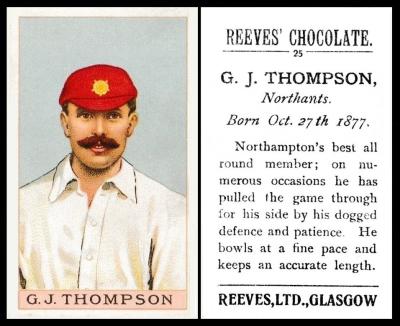
George Joseph Thompson, of Northants was, as it says on this card, born on October the 27th, 1877, and he was probably the best cricketer in the entire county. He started with the County as a teenager, and was snapped up by the Marylebone Cricket Club in the mid to late 1890s, though they did not use him until 1897.
Strangely, he only started playing for his Country in 1909, and his final Test came less than a year later.
It does not appear so on this card, but he was a striking man, well over six feet tall, and over sixteen stone in weight. This was not as much an advantage as you may be thinking, because he was lumbersome, and could be slow to get moving - though he was good on the field, where his large hands proved adept at catching and holding.
I cannot find any record of his service in the First World War, nor of an injury which is said to have prevented him playing until 1921, after which he could only bat, not bowl. This actually caused his retirement, not long after, in 1922 - yet he did not die until the third of March, 1943.
As for Reeves, Ltd., of Glasgow, almost nothing remains. We know that they retailed both chocolate and cocoa, and made other confectionery maker, and that their premises was right on the corner of Barrowfield and Stamford Streets, in Bridgeton, Glasgow, from about 1900. Like many early chocolate makers, Frank Reeve was a Quaker - however if you look at the apostrophe on the card, it bills the company as "Reeves`" rather than "Reeve`s", so there must have been more than one family member involved in some way.
There seems some confusion at the start, because Reeves is thought to have been connected in some way with British Automatic; however we think that arose because Reeves bought the factory from another company called Sweetmeat Automatic Delivery, who had made vending machines for sweets, and whose head office was 14 Appold Street, London. They were registered in November 1887 but had been a private business for a while. However it seems plausible that Reeves might have branched out by using the same machinery and filling them with their own sweets.
After Reeves left, it was used by various bakeries, Welma, and Sunblest. But today all have gone.
This set is described in our original British Trade Index as :
REEVES` Ltd. Glasgow
Chocolate. Cards issued about 1912,
- CRICKETERS (A). Sm. 63 x 38. Nd. (25) ... REK-1
Friday, 19th September 2025
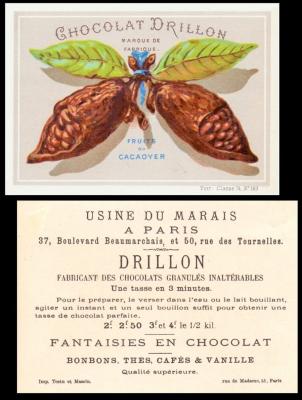
Drillon Chocolate, of Paris, seems to be a name vanished into the mists of time, but I am very intrigued by the fact that they make so much of "Fantaisies en chocolat". After all, we must have fantasy in our lives in some way, and there are few fantasies that are not at least doubly enhanced by the addition of just a soupcon of melting chocolate.
When I look at this card, I can only see this as such a thing, because though it may just be a representation of a cacao pod, it looks too three dimensional, and glossy, and the way that its innards, the shiny nubbins of fruit, are on display, firmly suggest that this is a fantasy constructed out of solid chocolate. And it`s really well done, though the way the stalks are tied does make it rather look like a gecko is coming over the top to attack you, eyes blazing ! That spoils the fantasy a bit.
Now the reverse of the card tells us that they were based at 37, Boulevard Beaumarchais, (a very plushy address, leading from the Place de la Bastille right to rue Saint Sebastien) and 50, rue des Tournelles (which led out from the Place de la Bastille in another direction).
They advertised chocolate that would make a drink in three minutes, as well as chocolate sweets, coffees, teas and vanillas.
And this card was printed by the great Testu and Massin.
But what ever happened to them, who knows? I have not found a thing.
So we kind of have something, which can be added to, over time. Only two days lacking and two days to do them in. It will work. It will.
Tomorrow I am off to Chesham Market(s), with nipper, and the only thing that will stop us is if it rains, because it is outdoors. I do have to wait for the carer though, as there is nobody else to let her in. I ought to still get there by lunchtime. There is the usual fruit stands, and fare, last time a couple of antiques ones too, but none with anything remotely cartophilic. However this time there will also be a Green Market, all about eco-friendliness and recycling, which sounds just my sort of thing. And, as far as I know, the trains will be running this weekend.
Then on Sunday we may go to Amersham Market, where I have never been. That will be a bit of a mystery tour as I have no idea whereabouts in Amersham it is but it must be shown online somewhere and I will look it up before I go out, so as to remember better.
If you are out marketing this weekend, good luck with your buying and your selling. And may the sun shine on us all, where-ever we are.
